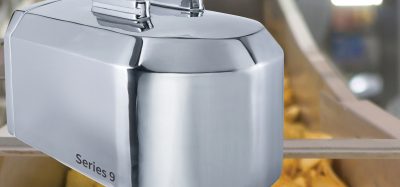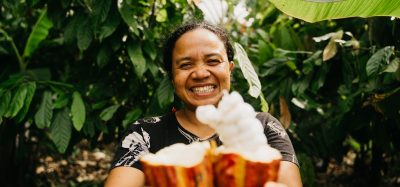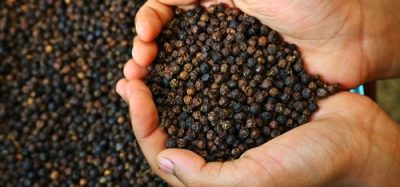The journey to truly sustainable packaging with Lignoo
- Like
- Digg
- Del
- Tumblr
- VKontakte
- Buffer
- Love This
- Odnoklassniki
- Meneame
- Blogger
- Amazon
- Yahoo Mail
- Gmail
- AOL
- Newsvine
- HackerNews
- Evernote
- MySpace
- Mail.ru
- Viadeo
- Line
- Comments
- Yummly
- SMS
- Viber
- Telegram
- Subscribe
- Skype
- Facebook Messenger
- Kakao
- LiveJournal
- Yammer
- Edgar
- Fintel
- Mix
- Instapaper
- Copy Link
Posted: 28 March 2025 | Ben Cornwell | No comments yet
In Part 2 of this month’s Ingredients for Change, we speak with Katerina Mouliadou, founder of Lignoo, about the importance of sustainable packaging, enhancing consumer transparency, and overcoming the challenges of creating truly eco-friendly water bottles.
The food industry is evolving, and with it, the conversation around sustainability. While efforts to reduce waste and minimise environmental harm are growing, real change requires more than just good intentions; it demands innovation, transparency and commitment. Lignoo, founded by Katerina Mouliadou, is addressing this challenge head-on.
There are some ideal materials on paper, but then when it comes to actioning it, it doesn’t work so well for your application…
Launched in 2023, the company is tackling one of the most overlooked yet essential aspects of sustainability: water bottles. Every minute, an estimated 1 million plastic bottles are purchased worldwide, yet less than 10 percent are recycled, contributing to the global plastic waste crisis.
However, in this era where single-use plastics and misleading ‘green’ claims dominate the market, Lignoo’s mission is refreshingly clear. “Lignoo’s mission is to provide innovative, research-backed, eco-friendly and safe consumer products, both for people and the planet,” says Katerina.
A personal drive for change
Katerina’s journey into sustainable packaging wasn’t purely professional; it was deeply personal. With a background in medical and health industries, she understood how products were designed and manufactured. However, when she became a mum, she also became hyper-aware of the materials she was exposing her child to. “Water bottles were a key issue that I faced,” she explains. “I thought there are so many materials out there, so many new technologies, that can make it better.”
But better is not always simple. Many brands market their products as sustainable by swapping one material for another, but as Katerina points out, that doesn’t always mean the entire product is truly sustainable. “The focus is often on incorporating a material that is trending or perceived to be sustainable by the consumer,” she notes. “So, they might incorporate that in one aspect of the product, but not the lid or the spout that comes in contact with the mouth, or the packaging.” The result? Confusion around how sustainable and safe the product is.
The battle for true sustainability
Creating a genuinely sustainable water bottle is no easy feat – there are constant battles.
The first hurdle? Materials. Lignoo sought to create a bottle from naturally derived, renewable sources while ensuring it remained durable and safe for everyday use. “Ideally, you want them to be degradable,” she explains. “But when it comes to making it come into contact with water, you don’t want your bottle to melt.”
Through partnerships with research centres and universities, Lignoo has benefitted from access to innovative resources and testing methods, refining their approach at every step. “There are some ideal materials on paper, but then when it comes to actioning it, it doesn’t work so well for your application,” Katerina reveals. The process of trial, error and innovation is ongoing, but the company is determined to bring its first bottle to market by the end of the year.
Transparency: the key to consumer trust
One of Lignoo’s defining principles is transparency. In a world where greenwashing is rampant, Katerina believes that honesty is essential. “You might have heard of the digital product passport,” she says. This concept, which is gaining traction in the EU, allows consumers to scan a QR code and access detailed information about a product: where it was made, what materials it contains, and how to properly dispose of it. Lignoo is proactively integrating this level of transparency into its products so that when it eventually becomes a mandatory requirement, they are ahead of the curve.
Who should take responsibility for change?
Sustainability is a shared responsibility, but Katerina firmly believes that businesses must lead the way.
People working together would be ideal, but I think this path needs to be done by the businesses. Consumers won’t be able to change unless given an option or a choice.”
Many companies argue that consumers must drive demand for sustainable products, while consumers often expect businesses to take the lead. According to NielsenIQ’s 2023 CPG sustainability report, 81 percent of consumers want to do the right thing and are making sustainability an important part of their lives, but 26 percent cited confusion as a key barrier to adopting more sustainable lifestyles.
This cycle of inaction is precisely what Lignoo seeks to break. “We need to be aware that there are some gaps in regulation that companies can get away with, providing a cheaper alternative,” Katerina warns. And the consequences of these shortcuts are not just environmental, they can impact human health, too.
“Nothing is more sustainable than something which is healthy for you to start with,” she points out. “Any choices that we make today, we’re going to face the consequences in the future, either in our own home or to our environment.”
Recognition and accelerating Lignoo’s impact
Katerina’s dedication and innovation have not gone unnoticed. She was recently named an Innovate UK Women in Innovation award winner, an achievement that has significantly accelerated Lignoo’s impact. “It has completely transformed our plans,” she says. “Because without the funding support, our development would have been a lot slower and more complex.”
The award has provided not just financial backing but also valuable business support, networks and mentorship. “And also, on a personal level, it’s great to see the recognition that your business idea and concept are valid, because it has been evaluated against about 1,500 other applicants,” she adds.
The future of sustainable packaging
While Lignoo’s water bottles may be the first step, Katerina has a much bigger vision for the future. “The business is not just about water bottles,” she says. “It is about the data that we create through our research and the methodology for getting there.”
Lignoo aims to share its findings with other businesses, encouraging industry-wide change.
I’m not looking to put patents in place or restrictions to prevent people knowing what I’m doing. I’m trying to share it as much as possible and encourage others to come along the way.”
The future of food packaging must go beyond aesthetics and marketing claims, it must prioritise environmental impact, consumer health and education. “There are a lot of large companies taking big steps when it comes to sustainable packaging,” Katerina acknowledges. “But balancing consumer education is really important. I have seen and come across so much new and different packaging, but as a consumer, we don’t know [it is different]. It just looks like any other film that was out there, ten years ago.”
Without proper guidance and education around ways to spot whether a product is biodegradable or bio-based, consumers might still unknowingly discard eco-friendly packaging incorrectly, undermining its benefits.
As we look to a greener, healthier future, Katerina’s message is clear: “We all need to be a lot more vigilant about what we put inside our mouths, what we eat, what we put on our skin, and what products we use daily.”
Reach out!
As part of our Ingredients for Change series, we are always on the lookout for the next wave of innovators and unsung heroes making a difference in the food industry.
If you know of individuals, companies, or initiatives advancing food safety, pushing for regulatory change, or transforming other aspects of the industry, we’d love to hear from you.
Contact our Assistant Editor Ben Cornwell ([email protected]) with your suggestions and help us spotlight the voices and solutions shaping the future of food!
Related topics
Beverages, Environment, New product development (NPD), Packaging & Labelling, Product Development, Research & development, Sustainability, The consumer







